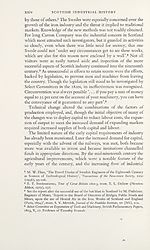Series 4 > Scottish industrial history
(30) Page xxv
Download files
Complete book:
Individual page:
Thumbnail gallery: Grid view | List view

INTRODUCTORY ESSAY
XXV
products overseas removed the strains placed on internal liquidity
by the need to import, and surplus funds were available, mostly
from agricultural sources and areas, for investment in industry.1
Frequently no transfer was required, since the main sources for
investment in many firms were their own accumulated profits, or
the resources of families which owned them, but where necessary
transfer was aided by the continued growth of those characteristics
of the banking system which had been pioneered in the eighteenth
century, notably the extension of branches, by over 50 per cent
between 1850 and 1865, and the growth in the nineteenth century
of joint stock enterprise and of the capital market, essential if the full
marketability of shares was to be exploited. Public utilities, notably
the railways, gained initially from joint stock enterprise. Partly
because of legal difficulties, manufacturing concerns were floated as
joint stock companies only later in the nineteenth century, and
sometimes not to raise capital for expansion but to enable a family
to surrender a leading financial stake in, but not control of, a
company.
It is less easy to overestimate the contribution of improvements in
the supply of labour than of capital. Its supply was transformed in
the nineteenth century when rising population in Ireland and in the
Highlands of Scotland coincided with increased demand from
Scottish industry, particularly the heavy industries. Coalmines and
ironworks used the unskilled labour; shipyards and engineering
workshops used the semi-manufactures they produced, but needed
skilled labour for their own output. The skills were geared to the
needs of the heavy industries, and with their success a labour force,
less mobile occupationally and geographically, emerged. But that
was a problem for the future.2
Of the increased quantity of labour there is no doubt; of its costs
the evidence is less certain. Yet cost was critical, because many
Scottish industries were labour intensive. In the 1890s labour costs
were estimated to be about 60 per cent of total costs; about 50 per
cent in finished steel; and from 33 to 66 per cent in shipbuilding.3
1 Checkland, Scottish Banking, 234. 2 See below, p. xxxvii.
3 Report to the Board of Trade on the Relation of Wages in Certain Industries to the Cost
of Production. British Parliamentary Papers, 1890-1, LXXVIII, 23. The official figures
agree with estimates made from the records of a number of Scottish firms.
XXV
products overseas removed the strains placed on internal liquidity
by the need to import, and surplus funds were available, mostly
from agricultural sources and areas, for investment in industry.1
Frequently no transfer was required, since the main sources for
investment in many firms were their own accumulated profits, or
the resources of families which owned them, but where necessary
transfer was aided by the continued growth of those characteristics
of the banking system which had been pioneered in the eighteenth
century, notably the extension of branches, by over 50 per cent
between 1850 and 1865, and the growth in the nineteenth century
of joint stock enterprise and of the capital market, essential if the full
marketability of shares was to be exploited. Public utilities, notably
the railways, gained initially from joint stock enterprise. Partly
because of legal difficulties, manufacturing concerns were floated as
joint stock companies only later in the nineteenth century, and
sometimes not to raise capital for expansion but to enable a family
to surrender a leading financial stake in, but not control of, a
company.
It is less easy to overestimate the contribution of improvements in
the supply of labour than of capital. Its supply was transformed in
the nineteenth century when rising population in Ireland and in the
Highlands of Scotland coincided with increased demand from
Scottish industry, particularly the heavy industries. Coalmines and
ironworks used the unskilled labour; shipyards and engineering
workshops used the semi-manufactures they produced, but needed
skilled labour for their own output. The skills were geared to the
needs of the heavy industries, and with their success a labour force,
less mobile occupationally and geographically, emerged. But that
was a problem for the future.2
Of the increased quantity of labour there is no doubt; of its costs
the evidence is less certain. Yet cost was critical, because many
Scottish industries were labour intensive. In the 1890s labour costs
were estimated to be about 60 per cent of total costs; about 50 per
cent in finished steel; and from 33 to 66 per cent in shipbuilding.3
1 Checkland, Scottish Banking, 234. 2 See below, p. xxxvii.
3 Report to the Board of Trade on the Relation of Wages in Certain Industries to the Cost
of Production. British Parliamentary Papers, 1890-1, LXXVIII, 23. The official figures
agree with estimates made from the records of a number of Scottish firms.
Set display mode to:
![]() Universal Viewer |
Universal Viewer | ![]() Mirador |
Large image | Transcription
Mirador |
Large image | Transcription
Images and transcriptions on this page, including medium image downloads, may be used under the Creative Commons Attribution 4.0 International Licence unless otherwise stated. ![]()
| Scottish History Society volumes > Series 4 > Scottish industrial history > (30) Page xxv |
|---|
| Permanent URL | https://digital.nls.uk/126655371 |
|---|
| Description | Over 180 volumes, published by the Scottish History Society, containing original sources on Scotland's history and people. With a wide range of subjects, the books collectively cover all periods from the 12th to 20th centuries, and reflect changing trends in Scottish history. Sources are accompanied by scholarly interpretation, references and bibliographies. Volumes are usually published annually, and more digitised volumes will be added as they become available. |
|---|


